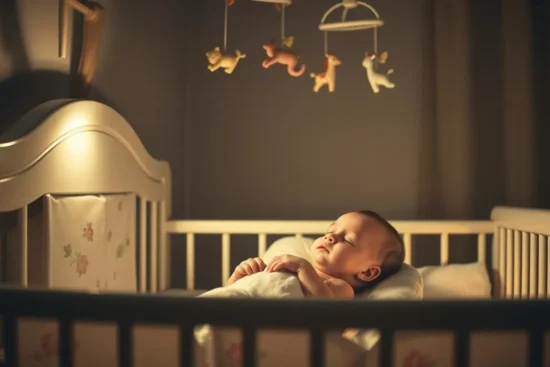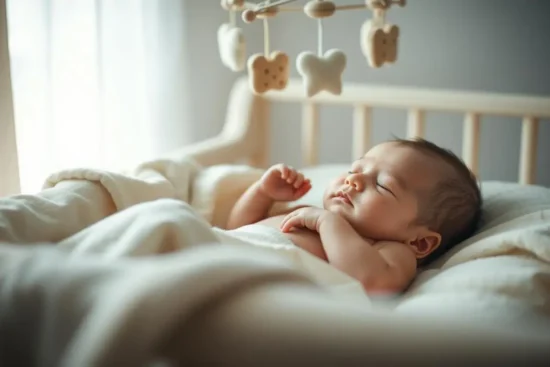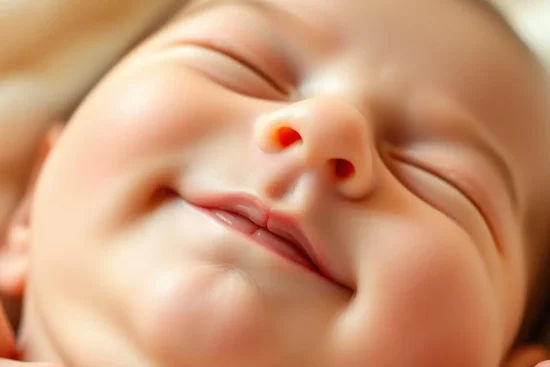
Are All Babies Born With Blue Eyes? The idea that all newborns have blue eyes is a myth. Science has shown that baby eye colors can be different.
Eye color comes from the amount and where pigment is in the iris. At birth, the iris might not be fully grown. This can make eyes look blue or gray. But, not all babies have blue eyes.
The science behind eye color is interesting. It involves genetics and how different genes work together. As we learn more about baby eye colors, we see that finding a baby’s eye color is complex.
👶 Must-Have Baby Products Every Parent Needs – Shop Top Picks on Amazon
Everything you need for baby’s first year — all in one place. 💗
Key Takeaways
- Newborn eye color can vary and is not always blue.
- The amount of pigment in the iris determines eye color.
- Eye color development involves genetics and multiple genes.
- Babies’ eye color can change over time.
- The final eye color is determined by several factors.
The Truth About Newborn Eye Color
Many parents are surprised when their baby’s eyes change color. This is because they think all babies are born with blue eyes. But, this is not always true.
The Common Belief vs. Reality
Not all babies are born with blue eyes. While many Caucasian babies start with blue or gray eyes, others don’t. The eye color at birth depends on the amount of melanin in the iris.
A study showed that most Caucasian newborns have blue or gray eyes. But, this is not the same for all babies. Asian and African newborns often have darker eye colors because they have more melanin.
Why This Misconception Persists
This myth might stick around because of cultural and media influences. Media and popular culture often show all babies with blue eyes. This makes people think it’s true.
What Determines Initial Eye Color
The eye color of a newborn is mostly decided by genetics. The amount of melanin in the iris is key.
- Genetics from parents affect melanin production.
- The amount of melanin at birth sets the initial eye color.
As a baby grows, melanin production can change. This can cause eye color to change too.

Knowing what affects newborn eye color helps parents enjoy the changes in their baby’s eyes.
Are All Babies Born With Blue Eyes? The Science Explained
To understand why babies are born with certain eye colors, we need to look at melanin production. Melanin is the pigment that gives color to eyes, hair, and skin. In newborns, the amount and how it’s spread out in the eyes determines their initial color.

Melanin Production in Newborns
At birth, many babies have gray or blue eyes because they don’t have much melanin yet. As they grow, more melanin is made, changing their eye color. This change is influenced by genetic factors, making each baby’s eye color unique.
The process of making melanin is complex and involves many genes. It’s not just about how much melanin is made but also where it goes in the iris. This complexity makes it hard to predict a baby’s final eye color.
Why Some Babies Have Dark Eyes at Birth
Some babies are born with dark eyes because of their genes. For example, many babies of African or Asian descent have darker eyes because they have more melanin at birth. This is due to their genetic makeup and is a normal part of human biology.
- Genetic predisposition plays a significant role in determining initial eye color.
- The amount of melanin present at birth varies among different ethnic groups.
- Eye color can change over time as melanin production adjusts.
The Role of Genetics in Eye Color Development
Genetics play a key role in determining eye color at birth and how it may change later. Many genes work together to control how melanin is made and spread. Knowing about these genetic factors can help clear up common eye color myths and give insights into each baby’s unique eye color development.
The mix of genetics and melanin production makes eye color development both fascinating and complex. By understanding these factors, parents can better appreciate the special traits of their newborn.
The Fascinating Timeline of Baby Eye Color Changes
Learning about when a baby’s eye color changes is both interesting and helpful for parents. It’s a mix of genetics and how much melanin is made in the iris.
When Eye Color Changes Begin
When Eye Color Changes Begin
Eye color changes start in babies between 6 to 12 months old. This is when more melanin is made in the iris, making the eyes darker or changing color. It’s part of how a baby’s eyes get used to the outside world.
Babies might be born with blue or gray eyes that turn brown or green as they grow. How fast and how much these changes happen can differ a lot between babies.
When Eye Color Typically Stabilizes
By the time a child is three years old, their eye color usually stops changing. But, some kids might see small changes until they are six years old.
The final eye color depends on how much melanin is in the iris. Things like genetics, ethnicity, and how genes work together play a role.
Surprising Fact: Some Adults’ Eyes Continue to Change
It’s interesting that some adults’ eye color can change a bit even when they’re grown up. This can happen because of aging or being in the sun a lot.
- Some adults might see their eye color get more defined or slightly change as they get older.
- Being in the sun can also change how much melanin is made, which can make eye color change a bit.
In summary, how a baby’s eye color changes is influenced by genetics and the environment. Knowing this can help parents enjoy watching their child’s eye color develop.
Surprising Genetic Factors That Influence Baby Eye Color
Figuring out a baby’s eye color is a complex task. It’s not as simple as just looking at who their parents are. Many genes play a role in eye color.
Beyond Simple Inheritance Patterns
Eye color is influenced by many genes working together. This makes it hard to guess a baby’s eye color. The genes control how melanin is made and placed in the iris.
Scientists have found genes like OCA2, HERC2, and SLC24A4 that affect eye color. Changes in these genes lead to different eye colors. The way these genes work together makes eye color hard to predict.
Heterochromia: The Two-Colored Eye Phenomenon
Heterochromia is when eyes are different colors or have multiple colors. It happens when melanin is not evenly spread in the iris. This can be from birth or caused by injury or disease.
Central heterochromia is when a ring of color surrounds the pupil. It shows how complex melanin distribution in the eyes can be.
Ethnicity and Its Impact on Newborn Eye Color
Ethnicity affects newborn eye color because of genetic differences. Babies of European parents often have blue or green eyes. Those from African or Asian backgrounds tend to have darker eyes.
Knowing about these genetic factors and how they relate to ethnicity helps us understand why eye colors vary so much in newborns.
Common Myths About Baby Eye Color Debunked
There’s a lot of confusion about baby eye color. Many parents wonder about their newborn’s eye color and how it changes. Let’s look at some common myths and facts about baby eye color.
The “Looking at Lights Changes Eye Color” Myth
One myth is that a baby’s eye color changes with light. But, eye color is determined by genetics. While light can make eye color seem different, it doesn’t actually change it. Studies show that melanin in the iris decides eye color.
Can You Predict a Baby’s Final Eye Color?
Predicting a baby’s eye color is tricky. You can make guesses based on the parents’ eye colors. But, genetics is complex, and many genes play a part. A baby’s eye color usually settles between 6 to 9 months. But, it can change until they are about 3 years old.
Surprising Fact: Eye Color Has No Impact on Vision Quality
A surprising fact is that eye color doesn’t affect vision quality. Blue, brown, or green eyes don’t change how well you can see. This is a common myth that needs to be cleared up.
The Truth About “Changing Eye Color” Products
Many products claim to change eye color, but these claims are often misleading. There’s no proven way to change eye color permanently without surgery. It’s important to be careful of products making such claims.
Understanding the facts and myths about baby eye color helps parents appreciate their child’s unique features. For more info, always talk to a healthcare professional.
Conclusion: Understanding Your Baby’s Unique Eye Development
Learning about newborn eye color and baby genetics is really interesting. Every baby is unique, and their eye color is just one special trait. At first, a baby’s eye color might change as their body makes more melanin.
Genetics play a big role in eye color, but it’s complex. You can’t always guess a baby’s eye color for sure. But knowing about genetics helps parents see how special their baby is.
Understanding newborn eye color and genetics helps parents see their baby’s growth. It shows how amazing and unique each baby is. This knowledge makes us appreciate the amazing journey of growing up.
FAQ
Are all babies born with blue eyes?
No, not all babies are born with blue eyes. Many newborns have dark eyes or eyes that look gray or cloudy. This is because of the amount of melanin in their eyes.
What determines a newborn’s initial eye color?
A newborn’s eye color is set by the amount of melanin in the iris. This is influenced by genetics. At birth, melanin levels are low. But as the baby grows, melanin increases, which can change the eye color.
Can you predict a baby’s final eye color?
Predicting a baby’s final eye color is hard. Genetics play a big role. Parents’ eye colors can hint at what their baby’s might be. But, many genes interact, making it complex. The final eye color might not be clear until the child is a few years old.
Why do some babies’ eye colors change over time?
Eye color changes happen as melanin levels in the iris increase. This can darken or change the eye color. This process can keep happening for the first few years of life.
Is it true that some adults’ eye colors continue to change?
Yes, it’s surprising that some adults’ eye colors can change. This can happen due to aging or certain medical conditions.
What is heterochromia, and how does it occur?
Heterochromia is when someone has two-colored eyes. It happens because of genetic variations. These variations affect how melanin is spread in the iris, leading to different eye colors.
Do “eye color changing” products really work?
No, products that claim to change eye color are not scientifically proven. They are often myths. Eye color is set by genetics and melanin production, making permanent changes hard.
Does eye color affect vision quality?
No, eye color does not affect vision quality. It’s a myth that eye color is linked to how sharp your vision is.







